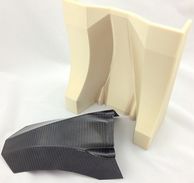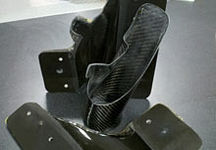- Commercial 3D printers & additive manufacturing solutions
- Order sample print
Carbon Fibre Layup with 3d Printer
Fibre–reinforced plastics are a group of composite materials consisting of a polymer matrix reinforced with fibers, that when combined together form a new material with physical properties exceeding those of either constituent material.The Carbon Fibre Layup with 3d Printer is great for:
- aerospace
- automotive
- sporting goods
- consumer goods
While hundreds of types of resins are available, each with distinct chemical and physical characteristics, the most common are the polyester and epoxy families. Different types of fibers are available as well; some examples are glass, carbon, Kevlar®, boron and even high–performance, high-density polyethylene fibre.
Two distinct categories of molding processes use fibres: wet layup, where the fibres are applied to a form and resin is poured and brushed into the cloth; and dry layup, which uses prepreg (pre–impregnated) fibers with resins already absorbed before the molding process. This process involves high temperatures and pressures to harden the prepreg fibers inside the mold and achieve the desired geometry. The prepreg method provides better penetration of the resin and more uniform resin thickness than the wet layup process.
This document will focus on manufacturing composite parts using hand layup, the simplest method for small–scale production. Highly advanced methods for fiber placement exist, but they require expensive equipment and therefore are only suitable for large–scale production or highly complex parts.
Increasingly popular customized parts in the composite material industry can lead to very expensive products, due to the need to create custom tooling that constantly changes. Traditionally, there have been two options to make the molds for the fiberglass layup process: CNC machining and handcrafting.
While both methods are used throughout industries, handmade tools are more prevalent in small– to mid–sized shops due to the expense, expertise and overhead needed for CNC machining.
A handmade mold is crafted in the same manner as the composite part itself, by layering resin–impregnated fabrics on top of a master model, curing the mold and removing the master to produce the cavity. This is a labor-intensive process requiring skilled workers, and substantial time will go into any iterations needed to adjust the mold to meet design specifications. Fiber layup has rather loose tolerances, in part due to the high rate of thermal expansion. When doubled — once for the mold and once for the part — the final dimensions can be difficult to predict.
Producing molds with 3D printing addresses many of these challenges, offering shorter lead times, lower expense and higher accuracy. The tool is fabricated in an automated process directly from a CAD file, meaning no iterative adjustment of the mold is needed to dial in part accuracy. This frees skilled shop employees to tackle other urgent tasks.
3D printing can also be used as a bridge to tooling, making parts on very short notice while a longer–term mold is being made.
Application Checklist
Polyjet or FDM molds are a best fit for fiber layup when:
- Production volume is low
- Geometries are difficult to machine
- Parts are customized or constantly changing
- Large and intricate detail is required for a mold or core
Benefits of PolyJet and FDM molds for fiber layup include:
- Reduced lead time
- Reduced cost
- Inert mold material that doesn’t inhibit curing
- Stability, eliminating distortion from heat
- Decreased core weight
Steps
- Print the mold or master directly from its CAD design on an inkjet or FDM system.
- If desired, polish the surface.
- Apply release agent so the part will be come away from the mold.
- Prepare materials by cutting fabric to fit the mold, mixing epoxy, and readying any additional components.
- Impregnate the fibers; in this stage the fibers first meet the matrix resin. It is important to make sure the fabric absorbs the resin well.
- Use pressure to eliminate air bubbles from the finished composite part. Numerous methods, including vacuum bagging, pressure bagging, or compression can achieve this.
- After the epoxy hardens, remove the part from the vacuum bag and trim excess fabric.
- Optionally, close the two halves together with glue inside the mold, then remove the strong, lightweight part from the mold.
- Application Outline — PolyJet
- Using inkjet technology to mold fiber–reinforced plastics is especially beneficial when the final product or part requires a very smooth surface finish. The fine slice thickness on inkjet systems reduces the surface preparation needed to produce a smooth mold.
In addition to molds, polyjet 3D printing can also be used to create masters for molds. Carbon fiber is wrapped around the inkjet master and left to cure. Once it has cured, the entire model can be used as a mold for other carbon–fiber parts. The inkjet master’s superior surface finish and short build time allow for high–quality, durable carbon–fiber molds to be used in various molding processes for a greater number of cycles.
Because resins tend to heat up as they cure, it is recommended to print the mold with one of the higher–temperature inkjet materials. The material used in the case described above is Objet High–Temperature material RGD525.
Application Outline - FDM
FDM is a viable tool-making option when the requirements include high temperature, high pressure, and low or moderate production volume. FDM materials are very durable and can withstand resins and epoxies that heat up to 200 C and vacuum pressures above 101 kPa. FDM molds can also be used as prototypes for prepreg composites because they withstand high temperature and pressure.
Sanding is not necessary (though it can improve surface finish) since a protective, barrier coat of epoxy will be applied. This top coat of epoxy will fill in build lines on the mold surface. Although sanding is unnecessary, the Stratasys smoothing process is highly recommended for the ABS–M30 material. This optional process will not only smooth the surface but it will also seal it, eliminating the need for epoxy.
In addition to molds, FDM parts can also be used as cores for fiber reinforcement. The FDM part can be printed in the quickest orientation, since the build layers are easily hidden under the composite. A sparse, double–dense or custom build style can be used to change the internal structure, reducing weight, build time and material consumption.
 Worcester (Head Office) 01905 458 000
Worcester (Head Office) 01905 458 000 3d@stanfordmarsh.co.uk
3d@stanfordmarsh.co.uk










